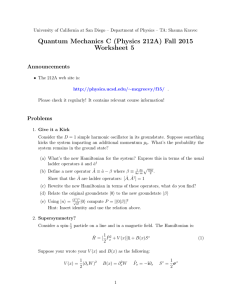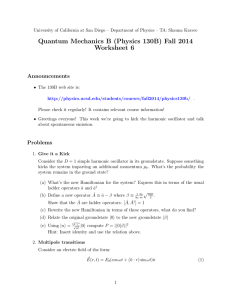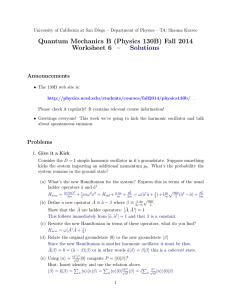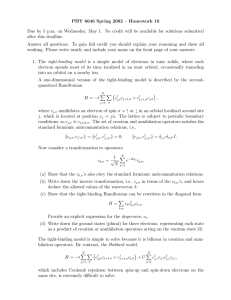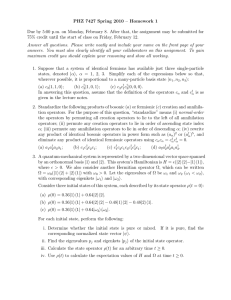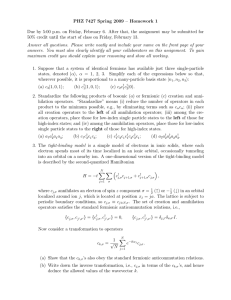Quantum Mechanics C (Physics 212A) Fall 2015 Worksheet 5 – Solutions
advertisement
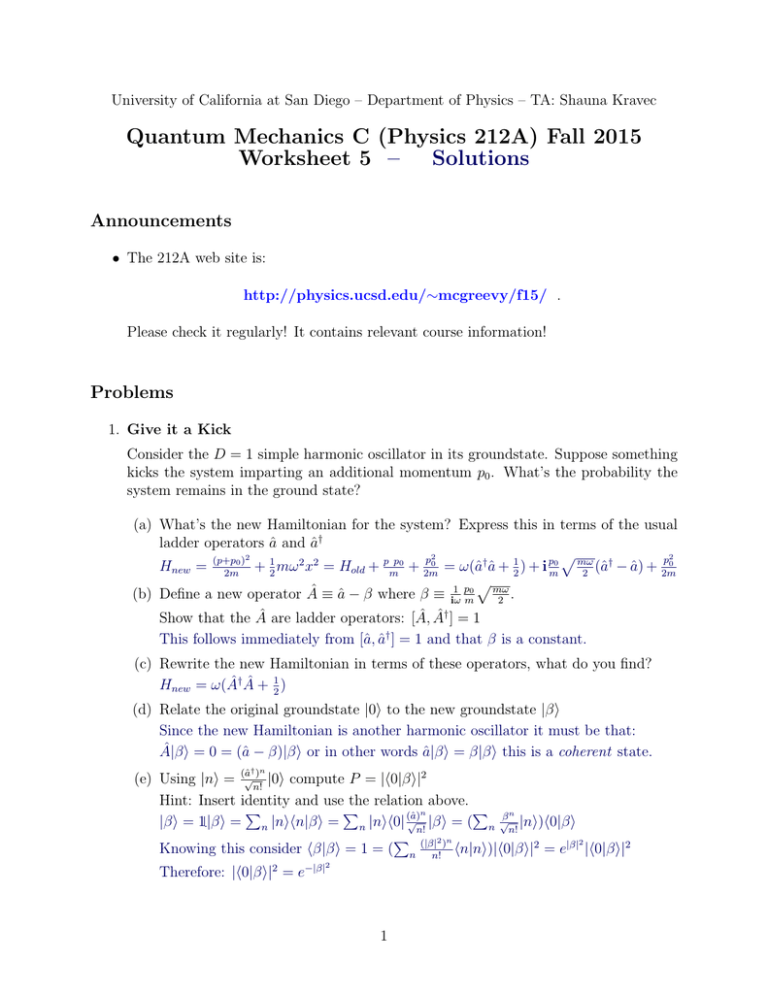
University of California at San Diego – Department of Physics – TA: Shauna Kravec
Quantum Mechanics C (Physics 212A) Fall 2015
Worksheet 5 –
Solutions
Announcements
• The 212A web site is:
http://physics.ucsd.edu/∼mcgreevy/f15/ .
Please check it regularly! It contains relevant course information!
Problems
1. Give it a Kick
Consider the D = 1 simple harmonic oscillator in its groundstate. Suppose something
kicks the system imparting an additional momentum p0 . What’s the probability the
system remains in the ground state?
(a) What’s the new Hamiltonian for the system? Express this in terms of the usual
ladder operators â and â†
p
2
p2
p2
0)
+ 12 mω 2 x2 = Hold + pmp0 + 2m0 = ω(↠â + 12 ) + i pm0 mω
(↠− â) + 2m0
Hnew = (p+p
2m
2
p
.
(b) Define a new operator  ≡ â − β where β ≡ iω1 pm0 mω
2
Show that the  are ladder operators: [Â, † ] = 1
This follows immediately from [â, ↠] = 1 and that β is a constant.
(c) Rewrite the new Hamiltonian in terms of these operators, what do you find?
Hnew = ω(†  + 12 )
(d) Relate the original groundstate |0i to the new groundstate |βi
Since the new Hamiltonian is another harmonic oscillator it must be that:
Â|βi = 0 = (â − β)|βi or in other words â|βi = β|βi this is a coherent state.
† n
(e) Using |ni = (â√n!) |0i compute P = |h0|βi|2
Hint: Insert identity and use the relation above.
P
P
P βn
n
√ |βi = (
√
|βi = 1|βi = n |nihn|βi = n |nih0| (â)
n n! |ni)h0|βi
n!
P (|β|2 )n
2
Knowing this consider hβ|βi = 1 = ( n n! hn|ni)|h0|βi|2 = e|β| |h0|βi|2
Therefore: |h0|βi|2 = e−|β|
2
1
2. Supersymmetry?
Consider a spin- 12 particle on a line and in a magnetic field. The Hamiltonian is:
1
Ĥ = [ P̂x2 + V (x)]1 + B(x)S z
2
(1)
Suppose your wrote your V (x) and B(x) as the following:
1
V (x) = (∂x W )2
2
B(x) = ∂x2 W
P̂x = −i∂x
1
S z = σz
2
Where W (x) is an arbitrary function known as the superpotential. Now define the
following operators:
Q = (P̂x − i∂x W )σ +
Q† = (P̂x + i∂x W )σ −
Where recall σ ± = 21 (σ x ± iσ y ) are raising and lowering operators. Q and Q† are
known as supercharges.
(a) Show that Q2 = 0 = (Q† )2
(σ ± )2 = 14 (σ x ± iσ y )2 = 1 − 1 + (σ z − σ z ) = 0
(b) Show that {Q, Q† } = 2Ĥ where recall {A, B} = AB + BA
Expand directly:
QQ† = (P̂x2 + (∂x W )2 + iP̂x (∂x W ) − i(∂x W )P̂x )σ + σ −
Q† Q = (P̂x2 + (∂x W )2 − iP̂x (∂x W ) + i(∂x W )P̂x )σ − σ +
Now we use σ + σ − + σ − σ + = 1 , and iP̂x (∂x W ) = ∂x2 W Sum the above:
(P̂x2 + (∂x W )2 )1 + (iP̂x (∂x W ) − i(∂x W )P̂x )σ z = (P̂x2 + 2V (x))1 + 2B(x)σ z = 2Ĥ
Note the integration by parts on −i(∂x W )P̂x
(c) Show that [Q, Ĥ] = 0 = [Q† , Ĥ]
[Q, Ĥ] = 12 ([Q, QQ† ] + [Q, Q† Q]) = 12 (Q[Q, Q† ] + [Q, Q† ]Q)
Now we expand using Q2 = 0 : = 12 (−QQ† Q + QQ† Q) = 0
Similarly for [Q† , Ĥ]
(d) We can also define F = σ − σ + which is also a symmetry of (1). Show [F, H] = 0
What are [F, Q] and [F, Q† ] ?
[H, F ] = 0 follows immediately from [σ − σ + , σ z ] = 0
Similarly [F, Q] = −Q and [F, Q† ] = Q†
(e) Note that the operators Q, Q† aren’t Hermitian but we can define Q1 = 12 (Q + Q† )
and Q2 = 2i1 (Q − Q† ). What algebra do they satisfy?
Q2i = H
Now what does supersymmetry do? Consider an eigenstate |Ψi with energy E.
2
(f) Compute hΨ|Ĥ|Ψi. What does this tell us about the ground state of the system?
hĤi = 12 (hΨ|QQ† + Q† Q|Ψi = 21 (|Q† |Ψi|2 + |Q|Ψi|2 ) ≥ 0
This implies that E = 0 =⇒ Q|Ψ0 i = 0 = Q† |Ψ0 i ; the groundstates respect the
symmetry
(g) Now also suppose that W (x) → ∞ as x → ±∞. Using
constraint on
the above
Ψ+ (x)
the ground state construct the wavefunction Ψ0 (x) =
in terms of W (x).
Ψ− (x)
Hint: It may be helpful to write:
0
0
0 P̂x − iW 0 (x)
†
Q=
Q =
0
0
P̂x + iW 0 (x) 0
This amounts to solving a pair of differential equations:
−i∂x Ψ± (x) ± iW 0 (x)Ψ± (x) = 0
where we’ve used that supercharges annihilate the ground state.
W (x) Ae
Therefore Ψ0 (x) =
where the above assumption of W (±∞) = ∞ and
Be−W (x)
normalization imply A = 0. Note that different asymptotic behavior of W change
our conclusion.
3. Fermions and Bosons
You may already know that SUSY mixes bosons and fermions. How does that appear
in this model? Let’s think about the spin Hilbert space H2 = span{|0i, |1i}
I encourage you to think about these vectors as being labeled by occupation number:
|0i has no fermion (it is bosonic) and |1i has a single fermion.1
The fermionic creation and annihilation operators are then simply: ψ̂ † ≡ σ − ψ̂ ≡ σ +
All states in the Hilbert space can be written as: |Ψi = f0 (x)|0i + f1 (x)ψ̂ † |0i
(a) Convince yourself the above is true and that F = ψ̂ † ψ̂ is a number operator
We’ve already shown that F is a symmetry and it’s clear that F |0i = 0 and
F |1i = |1i. Note also the ψ † ψ † |0i = 0
Now let’s show something non-trivial. I claim that all the excited (E 6= 0) states are
two fold degenerate into bosonic (F = 0) and fermionic (F = 1) pairs.
Let’s do this explicitly:
(b) Define |bi to be a state of the form Ψ(x) =
Ψ+ (x)
0
and |f 0 i ≡ Q† |bi. Show
that |f 0 i is fermionic and degenerate with |bi
H|f 0 i = HQ† |bi = Q† H|bi = E|f 0 i where I’ve used [H, Q] = 0
To check it is fermionic recall [F, Q† ] = Q† so F |f 0 i = (Q† F + Q† )|bi = |f 0 i
1
I’m being slick with notation as |0i, |1i are the computer science way of denoting the eigenvectors of σ z
for a spin system.
3
(c) Show also that the properly normalized states are |f i =
√1 |f 0 i
2E
†
hf 0 |f 0 i = hb|QQ† |bi = hb|2H − Q† Q|bi = 2E by using {Q, Q } = 2H
4. A Certain Magical Index
This model gives another interesting example of an index
It’s going to be useful to define the operator (−1)F , the fermionic parity.
(a) Prove that [(−1)F , H] = 0 = {(−1)F , Q}
The first follows immediately from [H, F ] = 0
And finally the object known as the Witten index
Tr [(−1)F e−βH ]
(2)
The object above is interesting as it only depends on the space of groundstates which
is independent of β and is invariant2 under deforming W (x) → λW (x)
(b) Show that (2) is equal to the number of bosonic groundstates minus the number
of fermionic groundstates.
P
Tr [(−1)F e−βH ] = n hn|(−1)F e−βEn |ni = nB − nF + nE1 (e−βE1 − e−βE1 ) + · · ·
= nB − nF where the pairing for states En > 0 was implied by the degeneracy
So for non-zero Witten index there must be some zero modes annihilated by the supercharges. This implies SUSY is not spontaneously broken.
5. The Harmonic Oscillator Redux
Consider W (x) = ω2 x2 in the above problem.
(a) Write the Hamiltonian. What are V (x) and B(x) ?
2
V (x) = ω2 x2 and B(x) = ω
(b) What’s the groundstate wavefunction? How does it depend on sign[ω]? What’s
the spectrum of the Hamiltonian?
|ω| 2
By above the spatial piece goes like ψ(x) = e− 2 x where sign[ω] determines if
the spin is up or down.
The harmonic oscillator part of the Hamiltonian and the spin portion commute.
Hosc |ni = |ω|(n + 21 )|ni and Hspin |0/1i = ± ω2 |0/1i
So En = n|ω|
(c) Calculate the Witten index (2) as well as the partition function Z(β) ≡ Tr e−β Ĥ
The Hilbert space factorizes as H = (L2 ⊗ |0i) ⊕ (L2 ⊗ |1i) = L2 ⊗ C2
Because the pieces of the Hamiltonian commute and the Hilbert space factorizes
this way we can evaluate:
2
In this sense it is topological.
4
Tr e−β Ĥ = Tr
L2 e
−βHosc
∗ Tr
C2 e
−βHspin
P
1
ω
ω
= ( n e−βω(n+ 2 ) ) ∗ (e−β 2 + eβ 2 )
)
Therefore Z(β) = coth( β|ω|
2
Similarly for the Witten index notice that (−1)F only acts on C2 so:
P
1
ω
ω
ω
IW = ( n e−βω(n+ 2 ) ) ∗ (e−β 2 − eβ 2 ) = |ω|
= ±1
There’s a lot more to this story, including some very beautiful mathematics, but we’ll
have to pause here without the technology of the path integral.
5
